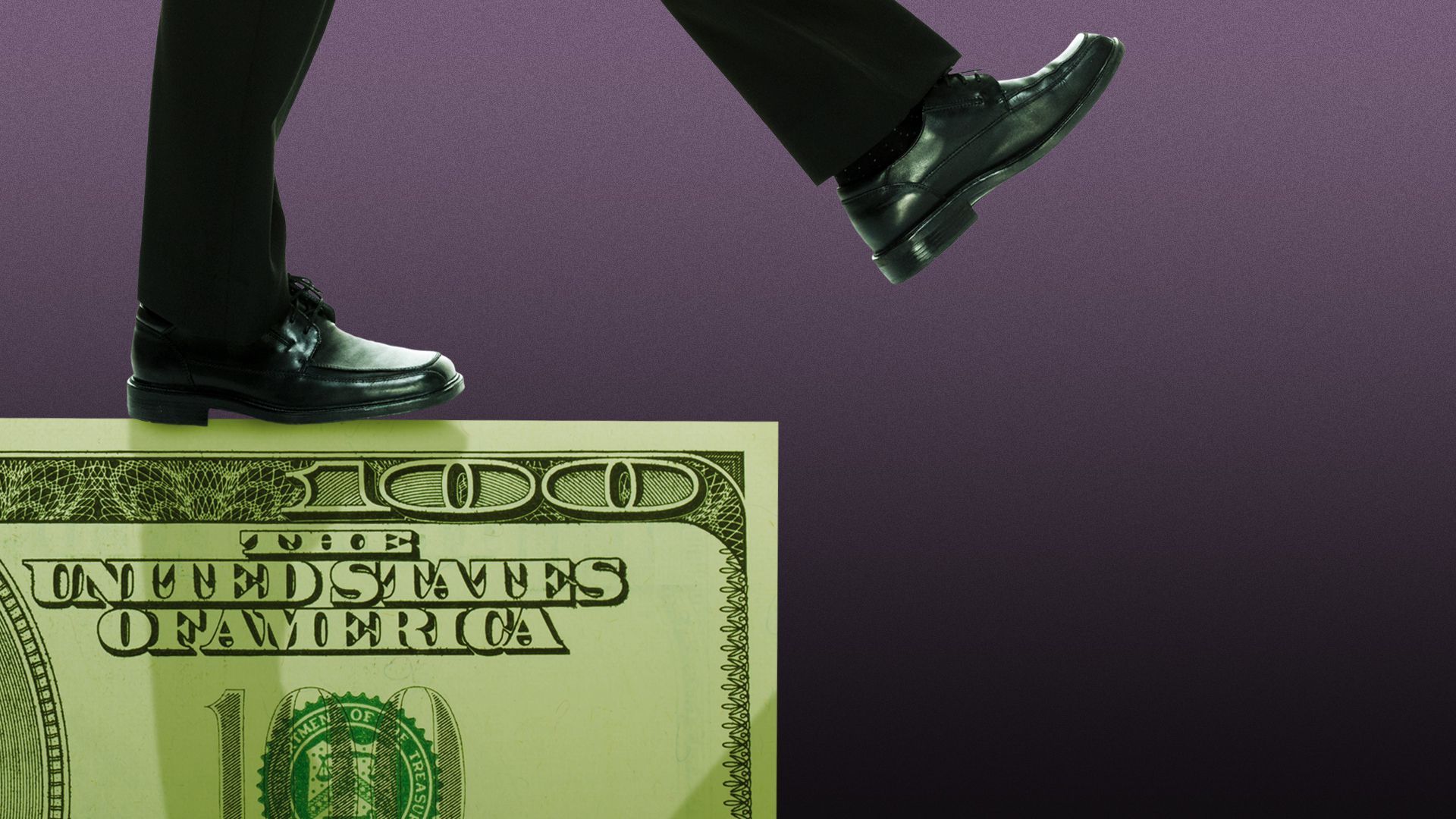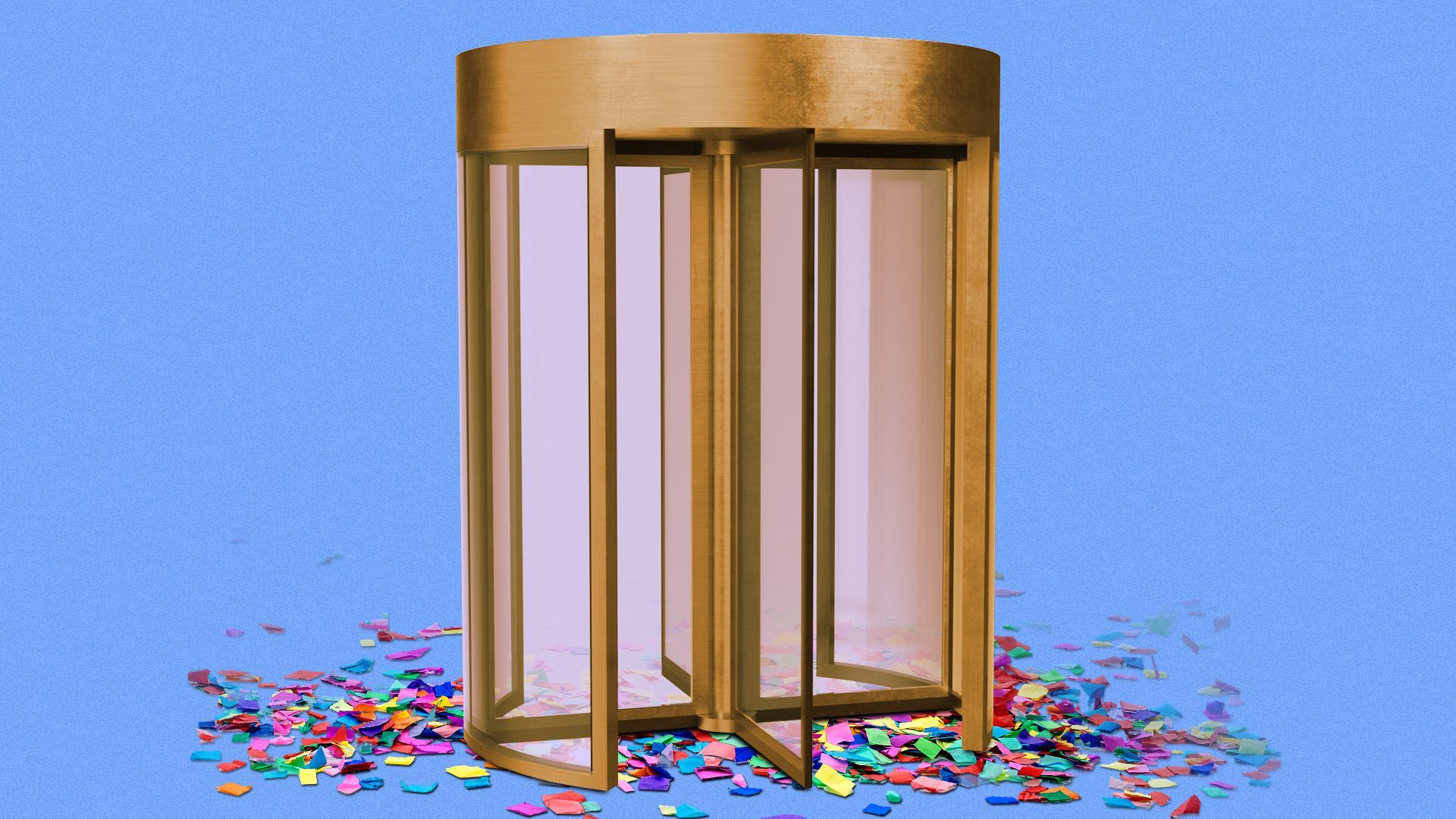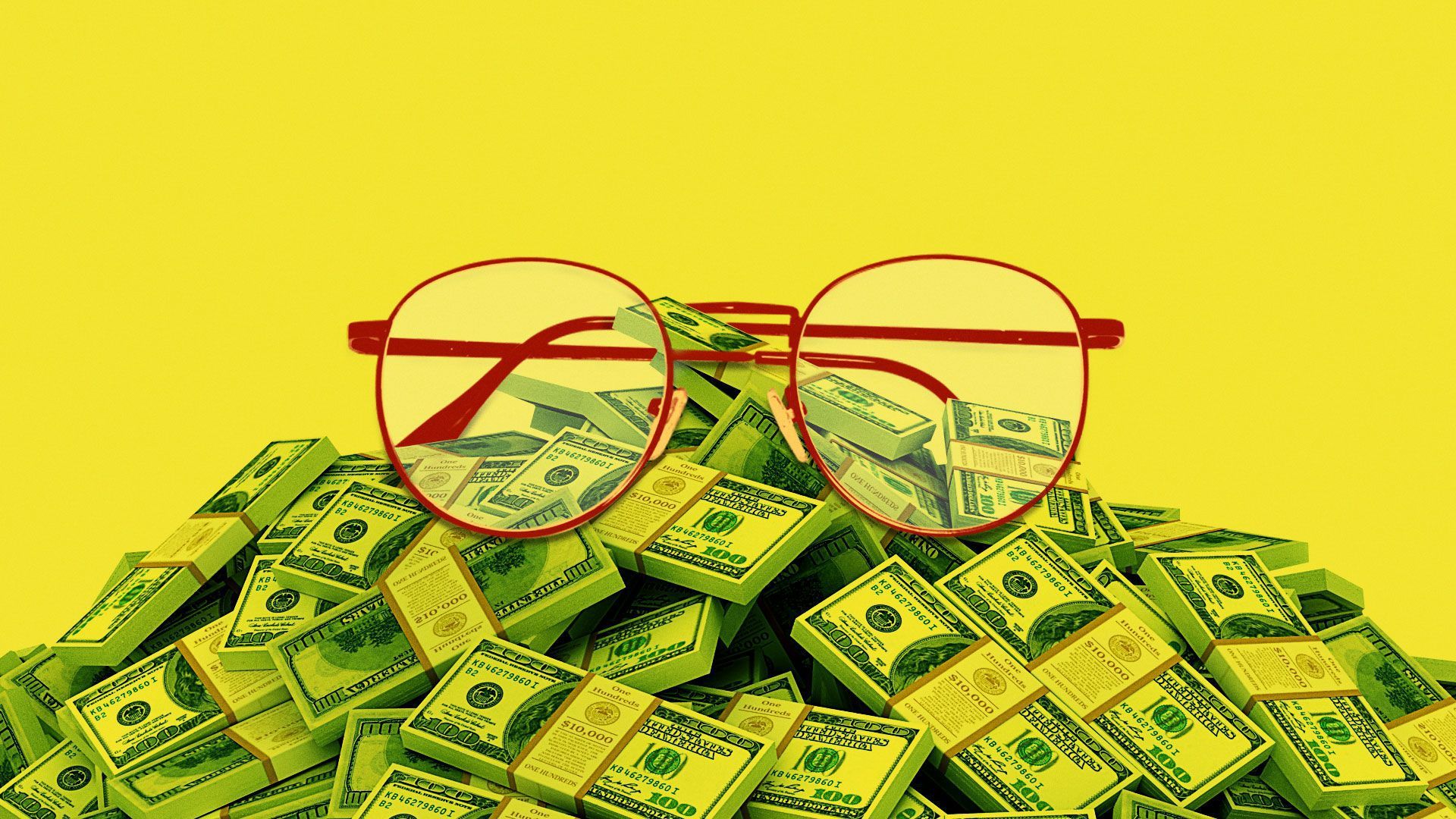Newsletter - Weekending September 24
Situational awareness: President Biden is set to nominate Saule Omarova to be America's top bank regulator. She wants consumers to be able to open accounts directly at the Federal Reserve, so expect aggressive pushback from the banking industry.
- In this week's newsletter: $35 experiences, debt-ceiling unknowns, Evergrande, revolving doors, and more. All in 1,774 words, a 7-minute read.
1 big thing: The experience experience
How much would you pay for "a sleek, if pleasantly confusing, package of moods" or "a confusing tangle of disjointed installations" or even "the total erosion of meaning itself"? The answer, according to the current market-clearing price, seems to be about $35.
Why it matters: Investors are pouring hundreds of millions of dollars into ticketed experiences — immersive, interactive museum-like spaces that don't have the d0-not-touch stuffiness of traditional museums.
Driving the news: Meow Wolf, a VC-funded art collective (now that's a phrase you wouldn't have heard 10 years ago) this week opened its biggest installation yet, in Denver. Clocking in at 90,000 square feet, it cost $100 million — the cost of a large studio movie, or an early Picasso.
- Immersive Van Gogh experiences now span the world, with just one operator, Lighthouse Immersive, claiming to have sold 3.2 million tickets.
- Superblue and Fotografiska, for-profit museums with VC funding and serious art-world credibility, are expanding across the country and the world. Their profits, if any, come not from selling works but from selling tickets.
- The biggest immersive experience of all, James Turrell's Roden Crater in Arizona, might actually open to the public in the next few years, thanks in large part to the generosity of Kanye West.
Nonprofit museums are paying attention. The Indianapolis Museum of Art, after rebranding as Newfields, now devotes an entire floor to immersive experiences; it's currently exhibiting a Van Gogh show.
- In Los Angeles, the Museum of Contemporary Art has opened a nine-month immersive exhibition of Swiss video artist Pipilotti Rist, who drew massive crowds to an earlier show at the New Museum in New York.
- The Paula Cooper gallery sold Christian Marclay's iconic installation "The Clock" — an immersive experience avant la lettre — almost entirely to museums.
The big picture: "The experience economy" is a phrase coined by management professors Joseph Pine and James Gilmore in 1998. Their thesis was that "businesses must deliberately design engaging experiences that command a fee."
- Thus were born "instagram museums" like the Color Factory or the Museum of Ice Cream. While they feel rather 2018, they haven't gone away entirely. Still, they're waning. "Having a factory to produce shared photos, I think that’s coming to an end," says Stewart Alsop, a board member and early investor in Meow Wolf.
- What's new is the way in which the pandemic has curtailed a lot of travel, and has increased demand for anything that can be enjoyed, with friends, while wearing a mask.
- By the numbers: The unauthorized traveling exhibition “Banksy: Genius or Vandal?” has reportedly sold 3 million tickets; at its current incarnation in New York, they cost $29.50 each.
The bottom line: Immersive art, at its best, can be revelatory. At its worst, it can feel like a cynical and disheartening attempt to hoover up the maximum amount of cash for the lowest possible outlay.
- As L.A. Times art critic Christopher Knight writes, "Actual art by a gifted artist is better than reproductions of art sold by a corporation any day — especially at one-third the price."
2. Stepping into the debt-default unknown

Illustration: Shoshana Gordon/Axios
No one wants to test the solidity of the debt ceiling. The current treasury secretary, backed up by many of her predecessors, says that it's so rock-solid that running into it will be catastrophic.
Why it matters: The brinkmanship we're currently seeing over the debt ceiling is the kind of dance that no sane person would perform on the edge of a real cliff. One possible explanation is that the cliff isn't quite as vertiginous as politicians are being warned it is.
What they're saying: The official stance on hitting the debt ceiling, from Treasury Secretary Janet Yellen, is positively apocalyptic:
Doing so would likely precipitate a historic financial crisis that would compound the damage of the continuing public health emergency. Default could trigger a spike in interest rates, a steep drop in stock prices and other financial turmoil. Our current economic recovery would reverse into recession, with billions of dollars of growth and millions of jobs lost.
Between the lines: The U.S. hasn't defaulted on its debt since Richard Nixon took the dollar off the gold standard in 1971.
- No one can be certain about the consequences of a default — and in fact there's no indication that the markets are concerned about such an event, with stocks near record highs and interest rates near record lows.
Where it stands: The two-year debt ceiling suspension enacted in 2019 ended on August 1, 2021. Since then, Treasury has been spending down its reserves. Absent another hike or suspension of the debt ceiling, at some unknown point in the next few weeks the government will be forced to default on all or some of its obligations.
Be smart: Most debt defaults are damaging because they cause financial harm to creditors. It's far from clear that a U.S. sovereign default would have that effect.
- In times of uncertainty, investors often turn to safe assets, and specifically to Treasury bonds. Moreover, when there's any problem with liquidity in the Treasury market, as there was in March 2020, the Fed has proved that it's willing and able to use its unlimited firepower to step in and buy as many Treasury bonds as the market wants to sell.
- A U.S. default, in contrast to most other defaults, would cause no losses: The recovery value would be 100 cents on the dollar. In that sense it would be akin to the technical defaults by Fannie Mae and Freddie Mac when the two agencies were placed into conservatorship in 2008. No creditors suffered losses when that happened.
Reality check: Hitting the debt ceiling would almost certainly cause harm to individuals who rely on timely checks from the government — members of the armed services, for instance, or people living on Social Security, or anybody receiving the monthly child tax credit.
The bottom line: Congress often waits to see market panic before acting. In a weird way, the worst outcome for the United States might be that the country defaults and the market barely wobbles. That could push the brinkmanship — and individual hardship — to even more ludicrous extremes.
3. The world's biggest no-big-deal default

Data: FactSet; Chart: Axios Visuals
The monster debt crisis that utterly failed to cause any catastrophe this week was that of Evergrande, the Chinese property giant.
Why it matters: Evergrande's share price has collapsed to pennies, its bonds are pricing in a default with very limited recovery, and even its customers are demonstrating across China. But so far the broader repercussions have been minimal.
Driving the news: Global markets fell on Monday on fears that Chinese markets would collapse on Wednesday morning, when they reopened after a two-day holiday for the Mid Autumn Festival. When Shanghai did reopen on Wednesday, it closed the day up rather than down.
- Between the lines: A deal with domestic bondholders, combined with the company's deep political connections at both the national and local levels, have combined to reassure investors that the Chinese government will contain any fallout.
Why it matters: Evergrande is the first big test of the global financial system — and especially the Chinese financial system — since the pandemic-induced chaos of March 2020, when central banks around the world were forced to take unprecedented measures to prevent total collapse. So far, world markets seem to be coping just fine.
Context: By any measure, an Evergrande debt default is likely to be one of the largest in history of the world.
- To put its $305 billion debt load in perspective, Argentina's massive foreign-debt default in 2001 was about $93 billion; Greece's restructuring in 2012 was about $200 billion; and Lehman Brothers had about $600 billion in debts when it filed for bankruptcy.
- Those defaults shook entire economies. Evergrande, by contrast, seems to have been successfully contained.
Between the lines: Evergrande debt has always carried a low junk rating, and the company was being described as "the biggest pyramid scheme the world has yet seen" as long ago as 2017. As a result, investors in Evergrande (EGRNF), much like investors in bitcoin or GameStop (GME), were acutely aware that they were taking a big risk.
- Financial crises generally happen when (seemingly) safe assets unexpectedly default, not when risky assets do something that was largely foreseen.
The bottom line: It's normal and healthy for markets to fall when giant companies fail. The fact that Chinese markets have been so sanguine this week implies the existence of some kind of "Xi put" — and the idea that Evergrande is, ultimately, too big to fail.
4. The Treasury Department's lucrative revolving door

Illustration: Sarah Grillo/Axios
A lot of government agencies can propel their public-sector employees into high-paying private-sector gigs. Sitting squarely at the top of the list is the Treasury Department.
Why it matters: Treasury has almost unlimited financial power.
- Treasury secretaries seen as being friendly to Wall Street — think Robert Rubin, Larry Summers or Tim Geithner — invariably exit to multimillion-dollar salaries in the financial sector. Steven Mnuchin has managed to do even better for himself.
Driving the news: Mnuchin has raised $2.5 billion so far for a private equity fund, including from Saudi Arabia, a country toward whom he was notably friendly while in office. If the fund is structured with a standard 2% management fee, that’s $50 million per year right there for Mnuchin and his colleagues, before they make a single penny from investment returns.
- What we're reading: The New York Times has an in-depth story about how accountants cycle into Treasury, do a tour of duty there that often involves enforcing the law in business-friendly ways, and then cycle straight back out to their own firms "with loftier titles and higher pay."
The bottom line: As Summers himself says, "The real scandal is not the illegal things people do, rather it’s what is legal."
5. Coming up: Warby Parker goes public

Illustration: Eniola Odetunde/Axios
Shares of Warby Parker are set to begin trading on the New York Stock Exchange next Wednesday, Axios’ Hope King writes.
Why it matters: The direct-to-consumer eyewear maker is going public via a direct listing, which means there's not going to be an IPO price.
- Its shares have traded privately this year at $24.53 each; if the company trades on the public markets at that level, it would be worth roughly $2.7 billion.
6. Building of the week: L'Arc de Triomphe, wrapped
The posthumous triumph of Christo and Jeanne-Claude, their L’Arc de Triomphe, Wrapped, was first conceived in 1961.
What they're saying: "Seen up close, the wrapped arch is an almost nonsensical sight. The monument is more than 160 feet tall and nearly as wide; rippling fabric doesn’t make sense for a structure of this scale," writes CityLab's Kriston Capps.
- French president Emmanuel Macron called it "a crazy dream come true".
The arch will be unwrapped and restored to its former state on Oct. 3.



